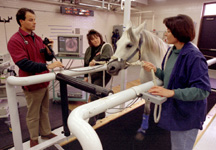 Purdue News
Purdue News
 Purdue News
Purdue News
The new treadmill is the most sophisticated, computer-controlled version of its type built to date, says Dr. Laurent Couëtil (cuh-TEEL), visiting instructor of large animal medicine at Purdue who is in charge of the treadmill.
 "Basically, the treadmill allows us to detect lameness and respiratory problems in
the equine athlete," Couëtil says. "The treadmill is a very safe tool that's been
used for several years by other veterinary schools. It's the wave of the future for
investigating the equine athlete's aptitude for performance and optimizing it. Ultimately,
it can aid us in understanding and preventing athletic injuries to horses."
"Basically, the treadmill allows us to detect lameness and respiratory problems in
the equine athlete," Couëtil says. "The treadmill is a very safe tool that's been
used for several years by other veterinary schools. It's the wave of the future for
investigating the equine athlete's aptitude for performance and optimizing it. Ultimately,
it can aid us in understanding and preventing athletic injuries to horses."
Couëtil broadly describes the equine athlete as any horse that takes part in athletic events, from polo ponies and race horses to a pleasure horse entered in a 4-H competition.
The treadmill is the heart of a new Equine Sports Medicine Center in the veterinary school. The purpose of the center is to diagnose, treat and research conditions unique to the athletic horse and to provide a laboratory setting for students in veterinary medicine and veterinary technology, says Dr. Hugh B. Lewis, dean of the School of Veterinary Medicine. The center has six faculty, four residents and three technicians.
What makes the Purdue equine treadmill unique, Couëtil says, is that it can be preprogrammed via computer with a standard exercise routine. That way, the horse's heart rate and respiratory rate can be observed with special sensors at specific speeds and inclines of the treadmill, and the same exercise routine can be repeated if necessary.
"Lameness isn't always detectable at a slow speed," Couëtil says. "We can videotape the horse while it's on the treadmill at a fast clip, then play the tape back slowly to detect any lameness."
Depending on the cause, lameness can be treated with surgery, drugs or controlled exercise such as that provided by the treadmill, Couëtil says.
The treadmill is about 15 feet long and flush with the floor. Two long metal rails on the sides keep the horse on the track. While the horse is in motion, clinicians stand on the outside of each rail, holding the halter ropes.
A strap around the horse's girth attaches to a hook on a pole over the track. If the horse stumbles or falls, the strap and pole are strong enough to support it while the animal regains its balance. An emergency brake stops the treadmill automatically.
Top speed on the treadmill is about 35 miles per hour, but going that fast can injure the horse. To reduce that risk yet still exercise the horse at full capacity, Couëtil says, the treadmill can be elevated as much as 10 degrees to get the same effect as all-out running.
"Horses are tremendous athletes," Couëtil says. "A horse's heart rate can go from as low as 20 beats per minute while resting to as much as 240 beats at maximum speed. That's a tremendous range."
But peak performance requires that the animal have sufficient air. A common problem in race horses is an upper-respiratory obstruction, which restricts the air in the windpipe, Couëtil says. The treadmill enables Couëtil and staff to perform what is called dynamic endoscopy, or viewing how the horse breathes while in motion. A long, flexible, black tube about the size of a woman's index finger is inserted inside one nostril of the horse and held to the head with Velcro straps. A small camera inside the tube projects images of the larynx and other throat structures onto a large video monitor. The images can be printed on paper or put on videotape for the horse owner to see.
Using the treadmill and a technique used in the study of the human nose and its diseases, Couëtil plans to study the role of a horse's nasal passages during respiration.
"The goal is to show that the nasal passages limit a horse's performance and to find ways to reduce that limitation," he says.
The treadmill and software cost about $73,000 and are made by SÄTO, a Swedish manufacturer. The endoscopic equipment cost about $76,000. The veterinary school acquired both pieces of equipment and the software through private gifts from individuals and two equine organizations and through funds from pari-mutuel racing. State legislation passed in 1992 authorizing pari-mutuel racing stipulated that a portion of the proceeds support equine research at Purdue.
Couëtil says other equipment may be added to the Equine Sports Medicine Center to enhance use of the treadmill. They include a gas analyzer to measure oxygen consumption and carbon dioxide production in exercising horses, and a pressure sensor to analyze the force with which a horse's hooves strike the ground.
About a half-dozen other veterinary schools, including Ohio State, Michigan State and Kansas State universities, have equine treadmills, but none is as sophisticated as Purdue's, Couëtil says. The Purdue treadmill is designed for use by both thoroughbred and standardbred race horses and any pleasure horse, Couëtil says.
Sources: Dr. Laurent Couëtil, (765) 494-8548; Internet, llc@vet.purdue.edu
Dr. Hugh B. Lewis, (765) 494-7608; Internet, lewis@vet.purdue.edu
Writer: Ellen Rantz, (765) 494-2073; Internet, ellen_rantz@purdue.edu
Purdue News Service: (765) 494-2096; e-mail, purduenews@purdue.edu
NOTE TO JOURNALISTS: Color photos and b-roll of a horse on the treadmill are available from Purdue News Service, (765) 494-2096 or download here.